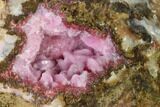This Specimen has been sold.
2" Roselite, Quartz and Calcite Association - Morocco
This is a unique crystal association collected from the Bou Azer District of Morocco. The deepest red coloration is a result of roselite crystals. Above that is a formation of calcite (cobaltoan calcite) that took on the magenta coloration as a result of impurities from the cobalt content within the surrounding rock. Small microscopic quartz crystals can be found peppered across the calcite.
Roselite is an arsenate mineral in the monoclinic crystal system. It gained its name not from the rose color it generally exhibits, but was in fact named in honor of a German mineralogist by the name of Gustav Rose. However, the name is quite fitting, since roselite typically displays a vitreous rose-red to pink color. Darker crystals have been known to frequently display marked color zoning due to variations in molecular composition.
Roselite has the chemical formula Ca2Co(AsO4)2 · 2H2O, meaning it contains arsenic. While it doesn't pose an immediate health risk from purely handling, ingestion in significant amounts and/or crushing and inhaling roselite can be toxic. For this reason, we suggest washing hands after handling and keeping out of reach of children.
Roselite has the chemical formula Ca2Co(AsO4)2 · 2H2O, meaning it contains arsenic. While it doesn't pose an immediate health risk from purely handling, ingestion in significant amounts and/or crushing and inhaling roselite can be toxic. For this reason, we suggest washing hands after handling and keeping out of reach of children.
Cobaltoan calcite, also known as cobaltocalcite, is one of many different varieties of calcite, forming with a chemical composition of (Ca,Co)CO3. It crystallizes in a trigonal crystal system and forms rhombohedral or scalenohedral crystals. These crystals tend to display a pink color that ranges anywhere from a pinkish-salmon to a hot pink.
About Quartz
Quartz is the name given to silicon dioxide (SiO2) and is the second most abundant mineral in the Earth's crust. Quartz crystals generally grow in silica-rich environments--usually igneous rocks or hydrothermal environments like geothermal waters--at temperatures between 100°C and 450°C, and usually under very high pressure. In either case, crystals will precipitate as temperatures cool, just as ice gradually forms when water freezes. Quartz veins are formed when open fissures are filled with hot water during the closing stages of mountain formation: these veins can be hundreds of millions of years old.
Quartz is the name given to silicon dioxide (SiO2) and is the second most abundant mineral in the Earth's crust. Quartz crystals generally grow in silica-rich environments--usually igneous rocks or hydrothermal environments like geothermal waters--at temperatures between 100°C and 450°C, and usually under very high pressure. In either case, crystals will precipitate as temperatures cool, just as ice gradually forms when water freezes. Quartz veins are formed when open fissures are filled with hot water during the closing stages of mountain formation: these veins can be hundreds of millions of years old.
SPECIES
Roselite, Quartz & Calcite
LOCATION
Bou Azer District, Morocco
SIZE
2 x 1.6"
CATEGORY
ITEM
#137024
 Reviews
Reviews














